People often ask us: what is traditional Croatian food? I have all that and more in this guide. I know all about food in Croatia; after all, I have been living in Croatia for a decade – and I am from a Croatian-Australian family. Keep reading if you want to try the best of the local Croatian cuisine.

Many blog readers ask about learning Croatian recipes, so we have those here, too, if you’re keen to start cooking authentic Croatian food.
Food from Croatia has many influences. Mainly from the Italians, Turkish, and Hungarians, plus a few others, this influence on food over the generations has shaped the types of Croatian food you’ll see and taste today.
Two of the most well-known Croatian foods are high-quality extra virgin olive oils from Istria and fig spreads/jams made from fresh figs from the Dalmatian Coast, which are available here.
Other well-known local Croatian traditional foods you should try on your adventures include Mljet lobster, Ston oysters, Kvarner scampi, Istrian truffles, veal and pork from Slavonia, turkey from Zagorje and Istria, Pag cheese, and the Lika cheese škripavac, delicious Palacinke pancakes, extra virgin olive oil, and pumpkin seed oil, and of course the wines.
We’re going to divide traditional Croatian food into a few categories below. There are sub-categories within these, but this makes it easy for you to know what Croatian dishes to try on your travels and where to find them.
Will you be sunning yourself on the coast? Then you’ll be eating coastal Croatia food – some of the best Croatian food.
But if you’ll be heading inland, you’ll be served continental Croatian cuisine. That’s not to say you won’t get the other in each area, though. The cuisine between these two regions is distinctly different. It just won’t be as easy to find.
Here is a snapshot of traditional Croatian food from both coastal Croatia and continental Croatia. Once you’ve finished reading this, you’ll never ask again, “What is typical Croatian food?”…
But before you go to our guide, here is a short list of gastronomic guided tours in Croatia:
Best gastronomic tours in Croatia:
Skip Ahead To My Advice Here!
My Kids’ Favorite Croatian Food
1. Croatian Kremšnite Recipe (Croatian Custard Slice)

Crispy pastry and custard. My kids love this. Kremšnite is also known as krempite – which is a mix of crispy pastry and a wobbly type of custard. They have been known to eat way too big a serving of this sweet treat. Regularly. This type of custard dessert is popular in Croatian cooking and in many other European countries. Within Croatia, the regional recipe variations are many. However, two things stay the same. They all include a puff pastry base with custard inside.
Croatian Food: Coastal Croatia
The coast of Croatia consists of three regions: Istria, Kvarner, and Dalmatia. They all have versions of these traditional Croatian dishes, so try them as you explore Croatia.
2. Peka
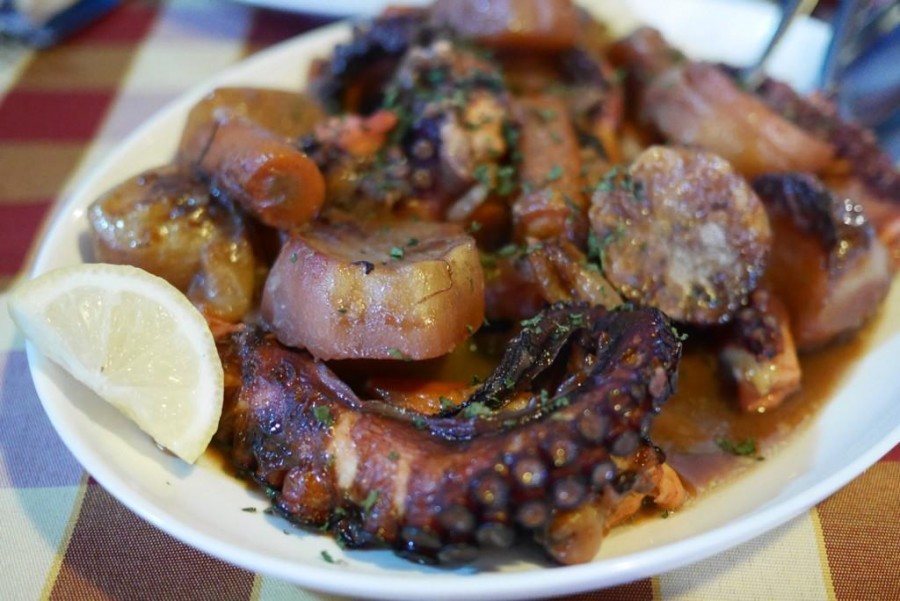
If there were a list of the most famous Croatian food, peka (also called Cripnja, depending on where you live) would unquestionably be on that list.
Peka is, however, not a food but a cooking method.
The peka is a dome or bell-shaped terracotta or steel lid that you heat by burning wood below it. Once heated, you place the food you wish to cook in a round-shaped tray underneath the peka and put embers on top of the peka itself, which then cooks your food.
What do you put inside?
Well, you can cook any meat or fish using the peka. Just remember that you always need to have potatoes, and I’d go so far as to say that the potatoes are the star of the dish. The potatoes suck up all the juices from the meat or fish and are so delicious you can’t stop eating them. Recently, we prepared an octopus, which was terrific.
This is Croatian cooking at its best. Such a simple dish, yet so delicious. Don’t forget to wash it down with a glass of Croatian wine!
3. Skradinski Rizot – Skradin Risotto
Anthony Bourdain showed the world this epic risotto when he filmed “No Reservations” in coastal Croatia a few years back, making the Skradinski Rizot a famous Croatian food!
This risotto is something special. Far from your regular risotto, it takes anywhere from 7 to 12 hours to cook. Yes, that’s right; it takes half a day and requires a team of men to share the cooking duties.
There is no strict recipe, but it’s essentially a veal-based risotto, with other meats and istrian ham (Croatian prosciutto) and a beef or rooster stock.
Once the Skradinski Rizot is done, the meal is finished with lots of Paski sir – cheese from Pag Island, which gives it that extra flavor.
Given the enormous effort that goes into cooking Skradin Risotto, you can appreciate that if you are going to make it, you should make tonnes of the stuff!
4. Brodet
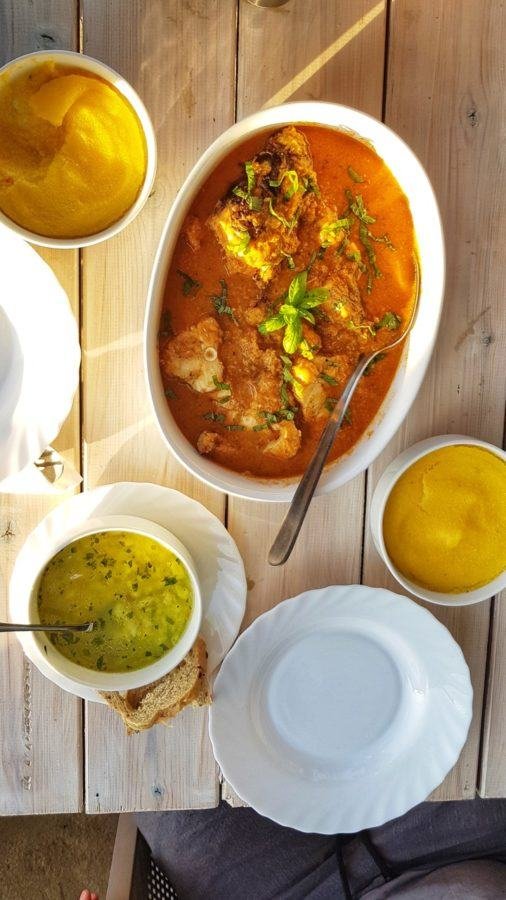
I absolutely love this classic Dalmatian food, and you will, too! Brodet or brudet, depending on where you’re from, is a Croatian seafood stew typically served with creamy polenta. It’s rich and has a great depth of flavor due to the mixture of all types of seafood used in the dish.
Ideally, you should use a minimum of three types of fish, any shellfish you like, and I also like to throw in a few crustaceans. This Croatian dish is served in homes up and down the coast and in the best restaurants, proving that it’s one of the best Croatian foods.
5. Pašticada
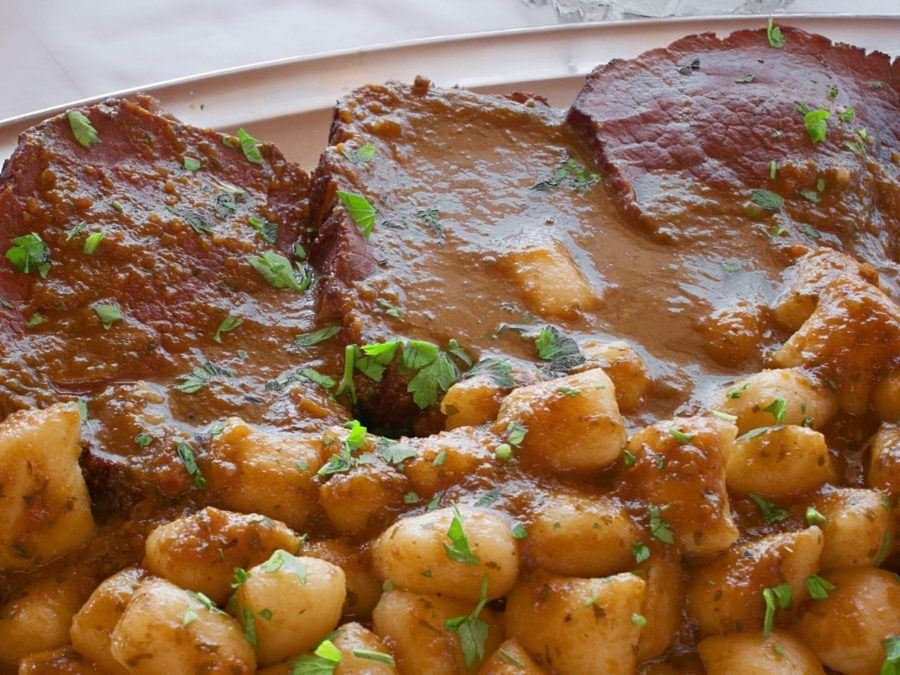
Pašticada is the holy grail of Dalmatian Croatian cooking.
This stewed beef dish in Dalmatia is prepared with a fabulous sauce. You may know it as Dalmatinska pašticada, Dalmatian pot roast, or even just as a beef stew. Whatever you know, this Croatian dish as it requires long and meticulous preparation. An excellent Croatian wine to go with this is plavac mali.
6. Soparnik
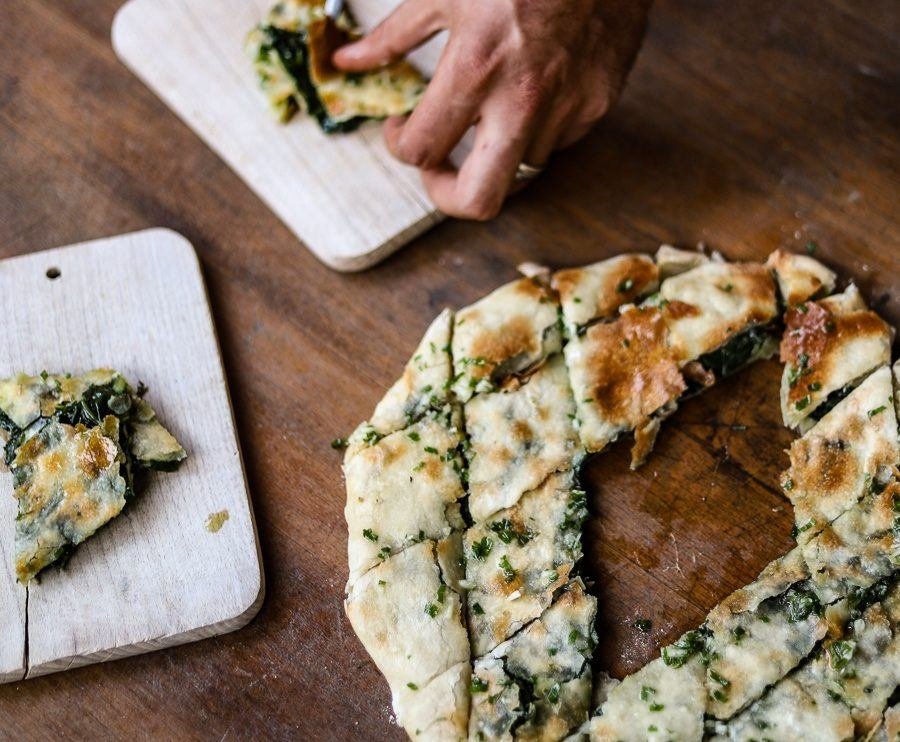
A flat vegetarian pie from Poljica in Dalmatia.
Soparnik is filled with swiss chard, garlic, and parsley and baked in a komin (a type of fireplace). Fire is created in the komin, and when ready, the fire and embers are pushed aside, allowing the soparnik to be cooked on the hot stone where the fire once was. Also, some hot ash and embers are placed on top of the Soparnik. This is a unique food from Croatia, which is well worth trying. Kids will especially love it.
7. Rafioli
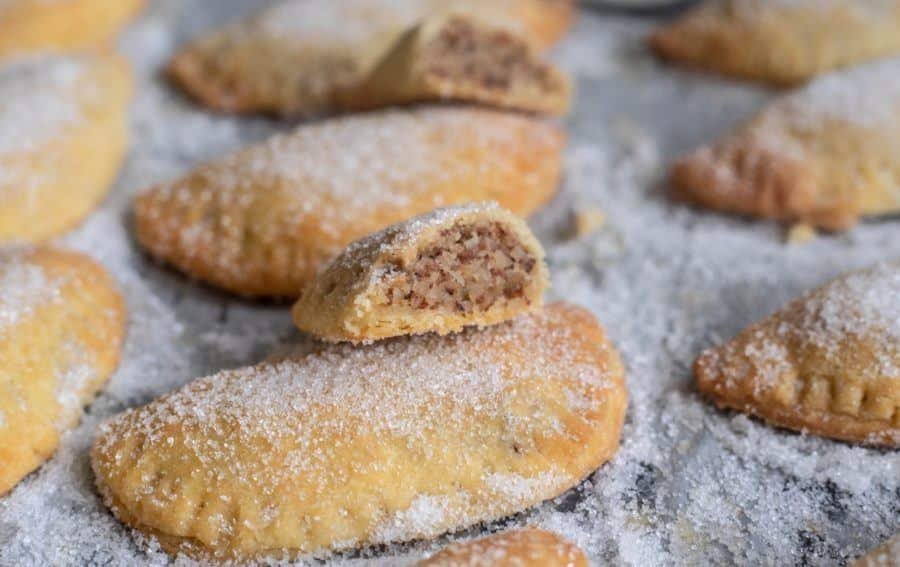
A typical coastal Croatian food, rafioli, is found all along the coast, from Istria to Dalmatia. Numerous varieties are known by their local name, including dalmatinski, trogirski, makarski, and sinjski rafioli. They are a staple at events like baptisms, birthday parties, and weddings. The fun thing about rafioli is that you can experiment and try out new ingredients—basically, every Croatian family has its own rafioli recipe.
Rafioli is a simple Croatian shortbread cookie traditionally filled with an almond filling. Modern versions can have different fillings, ranging from chocolate and cream to citrus and vanilla. The basics, however, are always the same.
8. Crni Rizot – Black Squid Ink Risotto

This dish has an intense seafood flavor. Croatian seafood is abundant, so one can always find fresh squid or cuttlefish for this traditional dish. Fresh seafood is integral to coastal Croatian cuisine, and you’ll find it dominates many restaurant menus.
This black, slightly intimidating-looking dish can be found all over Croatia, but it traditionally comes from Croatia’s coastal areas.
In my opinion, nobody prepares crni rižot better than your typical Dalmatian Konoba (small family-run restaurant). They always taste so damn good. Second on the list is my mother. Although squid risotto isn’t so black, it’s still absolutely delicious.
9. Bakalar
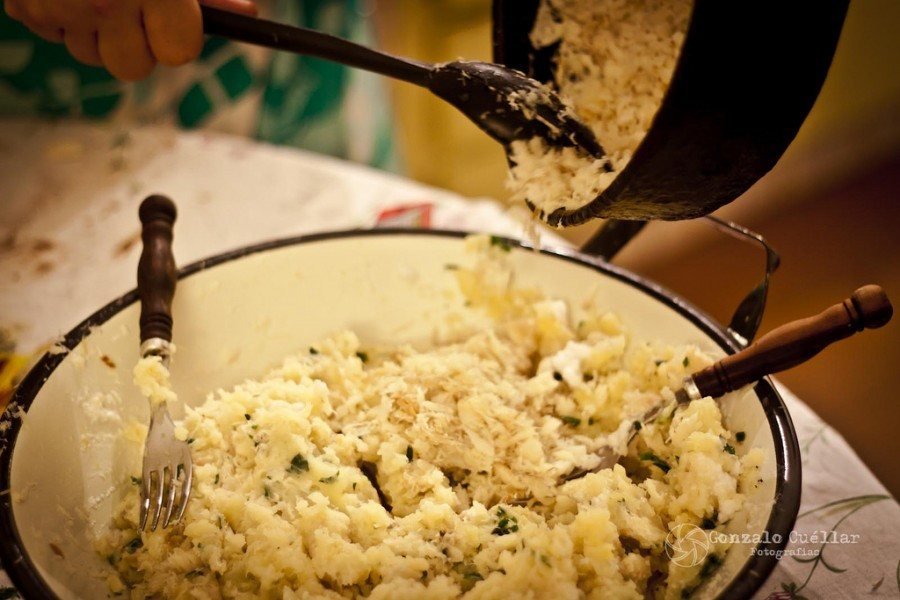
As it’s known in Croatian, a salted cod delicacy, Bakalar, is the must-eat traditional dish in our family for Christmas Eve or during the Christmas season.
Eaten across Croatia and in many parts of South America and Europe, the standard cod recipe can be adapted according to your taste. Add more garlic if you like, or change the ratio of bakalar to potatoes to suit your family.
10. Sinjski Arambaši

The cultural significance of this beautiful Croatian dish is undeniable. This famous dish from Sinj is on UNESCO’s Intangible Cultural Heritage list, making this a must-try food when visiting the Dalmatian hinterland.
Sinjski arambaši originated in Turkey, but like so many of the other best Croatian dishes, it has evolved into its own variety over time. A Croatian version of sarma, it resembles its culinary ancestor only slightly. These tasty cabbage rolls are filled with chopped beef and pork, smoked bacon, parsley, red onions, garlic, cloves, cinnamon, and a touch of nutmeg and boiled in water for a couple of hours.
11. Viška Pogača
A culinary classic on the island of Vis, viška pogača is a traditional stuffed bread pie that dates back at least 2,000 years. Similar to focaccia, pogača from Vis is baked bread filled with anchovies or other salty fish, onions, and, sometimes, tomatoes.
It almost looks like a regular round pie, eaten as slices, but it is definitely the bread and has a layer of hearty filling. This is arguably one of the oldest surviving dishes in Croatia.
12. Grilled Fish
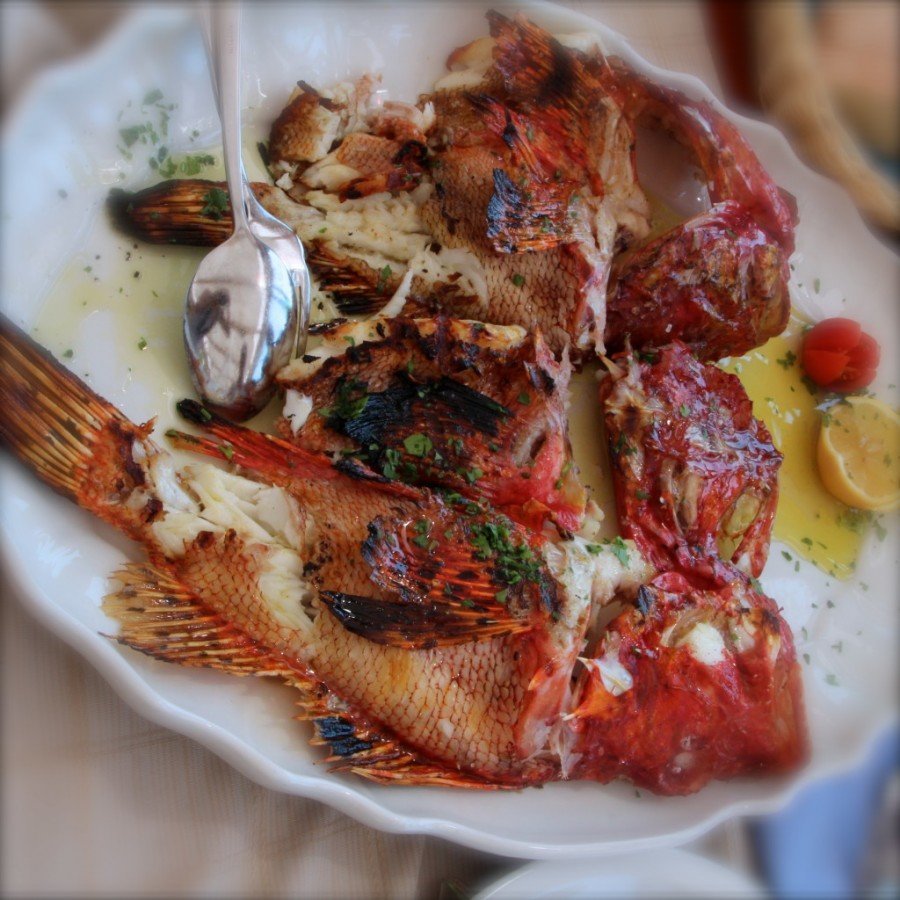
Seafood is a popular traditional Croatian food, which gets its excellence thanks to the Adriatic Coast being so clean, which means the fish are healthy and delicious. You would be hard-pressed to find a Croatian from Dalmatia, Istria, or Kvarner that does not like grilled fish.
This is typical Croatian cuisine, whether it be sardines, sea bream, sea bass, or scorpionfish. It is cooked only on a grill with salt, pepper, and olive oil.
13. Grilled Sardines

We live in Dalmatia, and Sardines is typical Croatian food to me. We eat them at least weekly in the summer! These delightful little fish need nothing more than a little olive oil and salt for a few minutes on the grill, and the fillets peel straight off the bone.
All you need to grill Sardines is to make a fire, wait till it dies down till you are left with embers, throw the grill on, and then the Sardines. It’s that simple. They are one of the best finger foods as you pinch the fillet, and it peels right off the bone. Don’t forget to wash these down with a glass of wine from Croatia.
14. Fuži
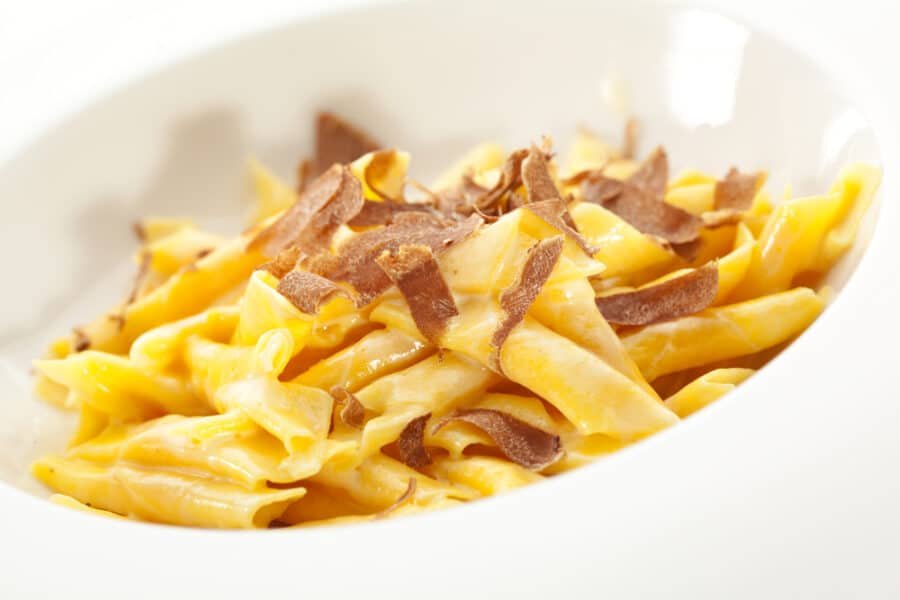
In Istria, you will find fuži {fooh-shee}, a type of pasta that, at a cursory glance, appears to be penne pasta. It’s not, though. Look closer, and you’ll see the difference.
When these hand-rolled pieces of pasta are served with the local specialty of white truffles, you think you’ve died and gone to foodie heaven. Matched with an Istrian white wine, fuži is the must-try dish in Istria, especially with some white truffle shaved over your Fuzi.
15. Octopus Salad
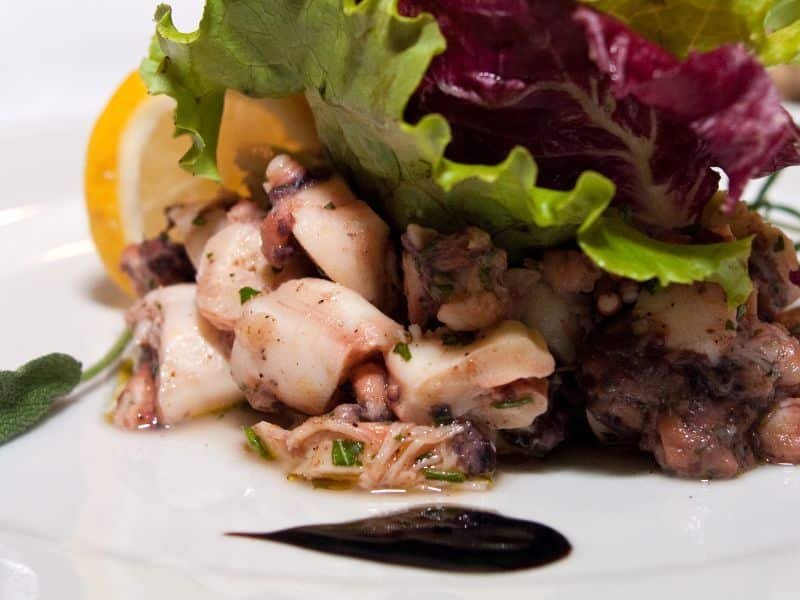
As the name suggests, this is a salad with octopus. Often served with potatoes, tomatoes, onions, and a little parsley, all chopped up super-small.
The freshest octopus makes the best salad, and the Adriatic waters are rich with this tentacled creature! The octopus is chopped up small and tossed in olive oil, garlic, salt, lemon, pepper, vinegar, and salad. Light, delicious, and fresh, this dish is perfect for summer when the sun beats down.
16. Edible Dormouse
Yes, it is what the name would suggest; it’s a type of mouse. And it is considered a delicacy on the islands of Hvar and Brač. If you spend some time on these islands, it’s worth trying! The dormouse is cooked on the grill, seasoned with salt, and cooked in olive oil before being served between two slices of bread.
17. Pašta Fažol
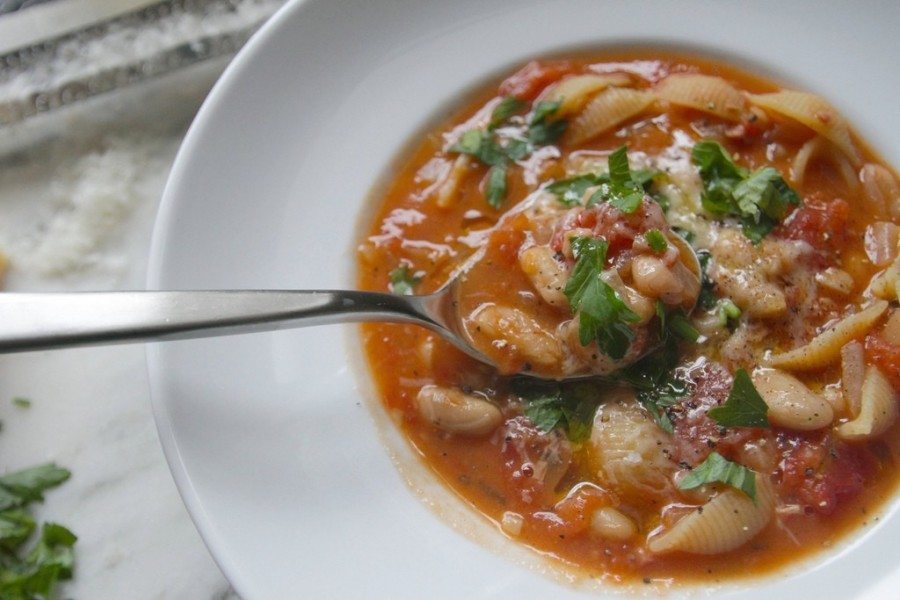
You will find this hearty and delicious pasta and bean soup everywhere (including in my kitchen).
A real mixture of ingredients, the soup/stew usually contains pancetta, sausage, potato, garlic, carrots, onion, and pasta shells. There may also be a few other regional tweaks and differences from household to household.
You will find this on the menu in most traditional households during winter and at many authentic restaurants.
18. Rožata
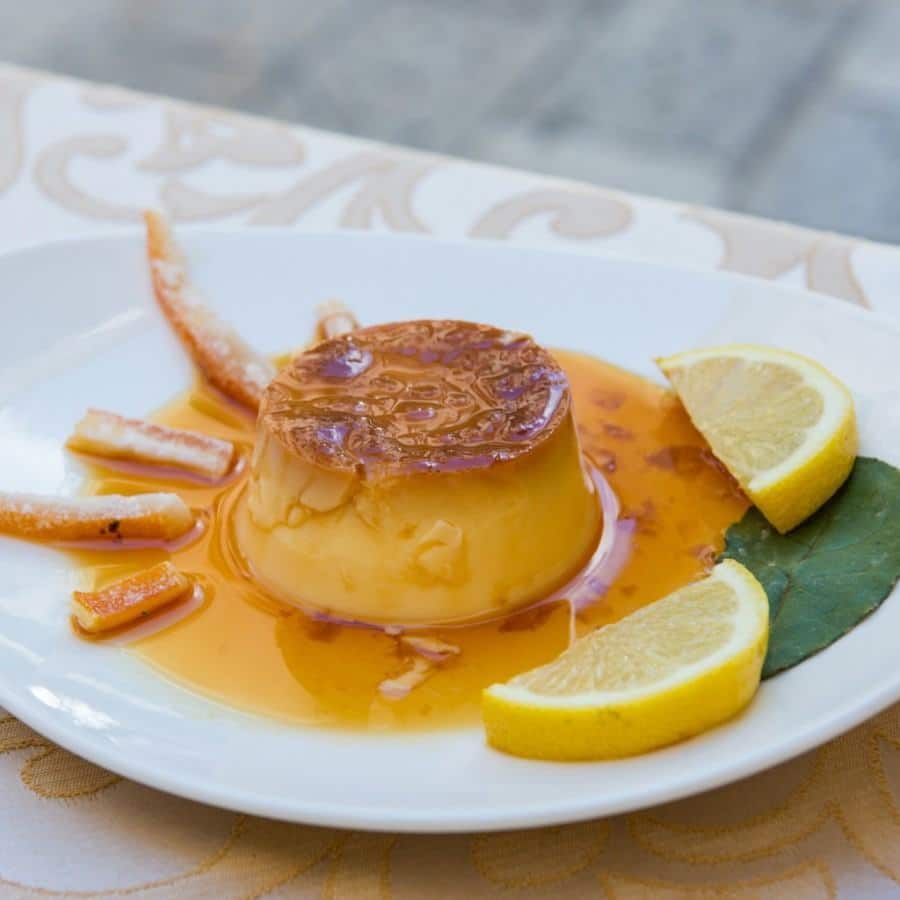
Hailing from Dubrovnik, this is one of my favorite desserts. Rozata is a pudding made of custard, but it’s super-creamy and usually surrounded by syrup. Made in a small bowl, the pudding is tipped upside down to serve and surrounded by the syrupy goodness we just mentioned.
19. Pjukanci
Istria was once a part of Italy—you can still see street signs in Italian and Croatian—and this heritage continues to shine through in the regional cuisine. Take pjukanci, for example, a traditional Istrian pasta that shares a common history with Italian kinds of pasta.
Also known as makaruni, you make this pasta by rolling the dough between the palms of your hands until you get a string of pasta. Ideally, for real pjukanci, the strings should be thicker in the middle and thin at both ends. The dough is nothing more than flour, salt, hot water, and a sprinkle of oil. Istrian pjukanci is phenomenal with meat sauces or fresh seafood.
20. Neretvanska Mandarina

Although this is not an authentic Croatian dish or recipe, it is a classic, traditional Croatian food or ingredient from the southern Croatian coast. Neretvanska Mandarina—mandarins from Neretva—are aromatic and sweet citrus fruit grown and produced only the Croatia’s Neretva River Valley in southDalmatia.
Easily peeled and segmented, these sweet fruits are hugely popular throughout Croatia. Nowadays, the Neretva mandarin farms are a tourist destination, too. The mandarin harvest takes place from September through November and allows visitors to participate.
21. Kroštule
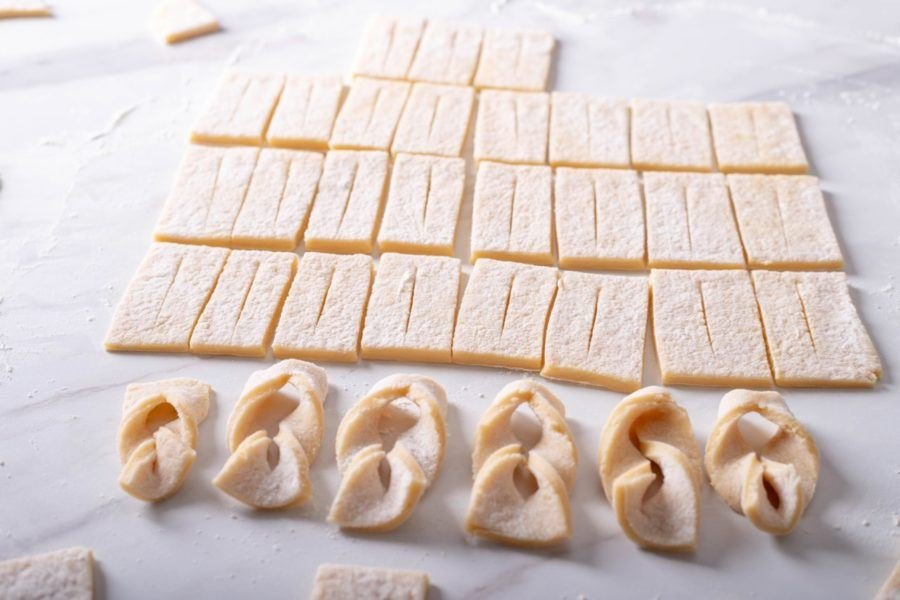
An incredibly popular dessert or sweet treat in coastal Croatia, kroštule are a type of sweet pastry knots. They are especially popular between Christmas and Easter, particularly around Carnival.
Originating from the coastal regions of Dalmatia and Istria, this crunchy deep-fried dessert is super-easy to make. The dough consists of little more than flour, sugar, egg yolks, milk, and oil. Powdered sugar is sprinkled on top to give them an even more festive look. Additionally, flavorings can include lemon zest, orange liqueur, or limoncello.
Brands We Use And Trust
More Traditional Coastal Food Options
- Sardines
- Pag Island cheese (Paški Sir)
- Maraschino liqueur
- Mišni sir
- Žižula
- Skradin cake
- Luganige (sausages)
- Arancini (sugar-coated orange, grapefruit, and lemon peel)
- Rab cake
- Chesnuts
- Šurlice
- Lika potatoes
- Basa
- Škripavac cheese
Croatian Food: Continental Croatia
Venturing away from the Adriatic Sea, what traditional Croatian cuisine will you be served over the Velebit in Zagreb and a Slavonian town like Osijek? Let’s see below.
22. Punjene Paprike – Stuffed Peppers
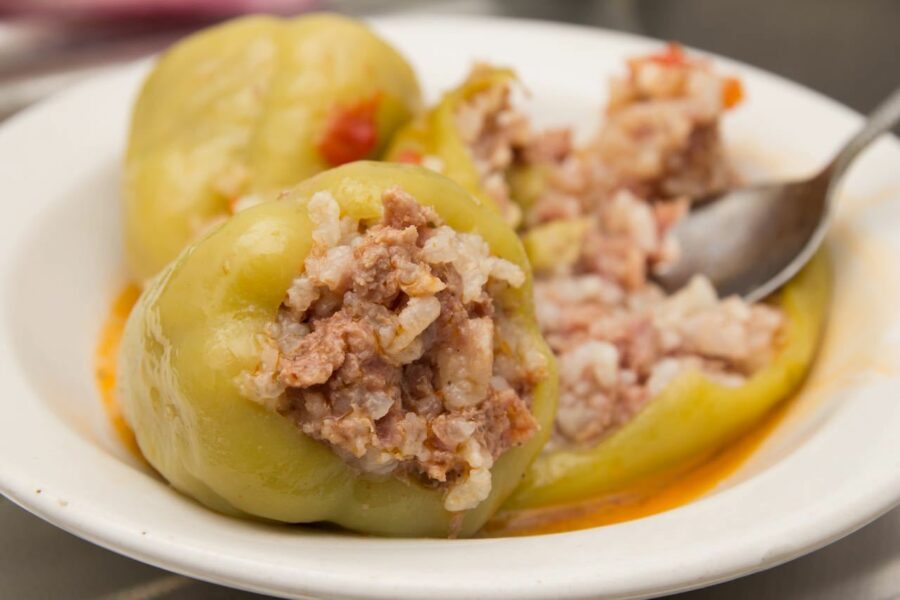
Stuffed peppers are a hearty dish of mincemeat and rice. You will find punjena paprika typically served with mashed potato. You’ll find most countries have their version of stuffed peppers. However, I think the Croatian stuffed peppers are the best (of course!). You’ll find stuffed peppers on offer in Croatia as soon as the peppers are in season.
Every Croatian I know has their variation of this recipe, and they all claim that their way is the best way to make them.
23. Štrukli
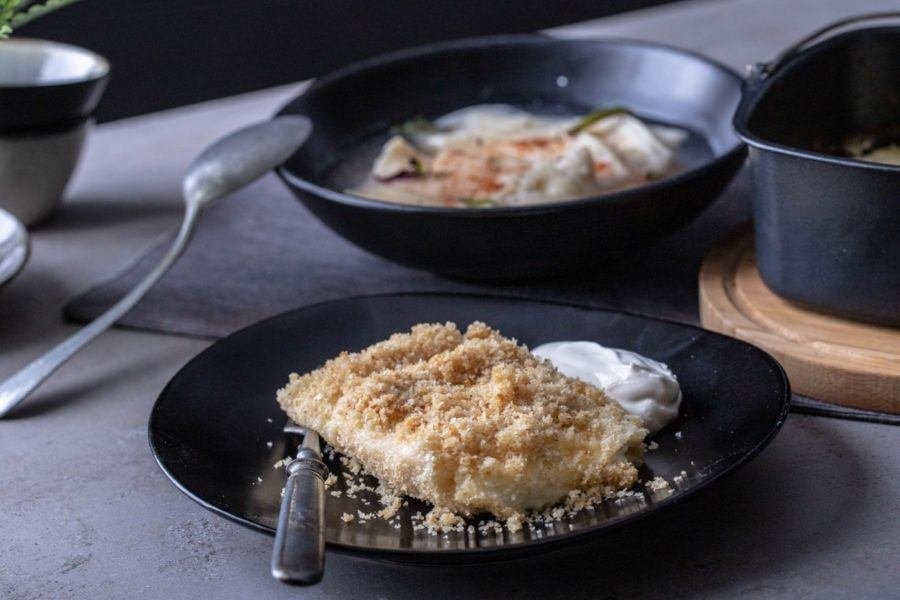
Zagorski štrukli is a popular traditional Croatian dish served in households across Hrvatsko Zagorje and Zagreb regions. It consists of dough and various types of filling, which can be either cooked or baked. Our favorite is cheese štrukli!
24. Cobanac

This hearty meat stew is traditionally cooked in a cauldron hung over an open fire. Cobanac will keep you going all day long, as it did Slavonian shepherds for many generations. Not only will it sustain you all day, but the best part is that it’s super delicious.
And, of course, the essential ingredient of Slavonian cuisine is PAPRIKA! This traditional dish is typically prepared with three types of meat: beef, pork, and anything you like (I like throwing a little wild game in). After that, people tend to put whatever they like in their stew, from potatoes and onions to pancetta, carrots, and various herbs. You can find this everywhere in Slavonia, and you must try it.
25. Šaran U Rašljama

Carp cooked on a wooden fork/stick on an open fire. Simple and tasty is šaran u rašljama! Sea salt, red ground sweet paprika, and hot paprika are added, then cooked for about 2 hours. Each carp weighs about 1.5 kg to 2 kg.
I tried my best to speak with the chef (who spoke no English), and as I understood, you turn them just once, about halfway. They take two hours to cook thoroughly, no more, or they become dry. The fire must be made using wood to achieve the desirable smokey flavor. He also told me that there is no garlic or oil added. This seemed weird to me, as they are the main two ingredients for fish in Dalmatia, where I live.
26. Turkey With Mlinci
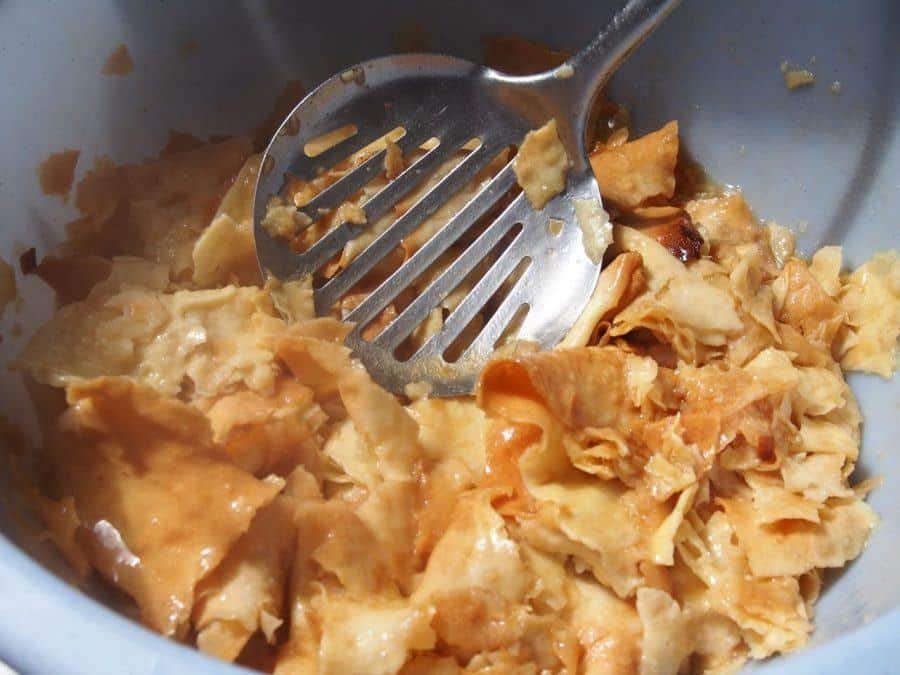
Well, I am sure you know what roast turkey is. But I guess that those of you who are not Croatian would not have heard of mlinci, am I right? Mlinci is a thin, dry flatbread broken up into pieces and mixed with the roasting juices from a roast turkey. The juices make the mlinci soft and somewhat like noodles. They suck up allthose delicious juices and carry a turkey flavor.
Sadly, they do not look very appetizing but don’t let that stop you from eating them. Just don’t be like Mrs. Chasing the Donkey, who always eats too many and forgets how quickly they fill her up, and she can’t finish the turkey.
27. Fish Paprikaš
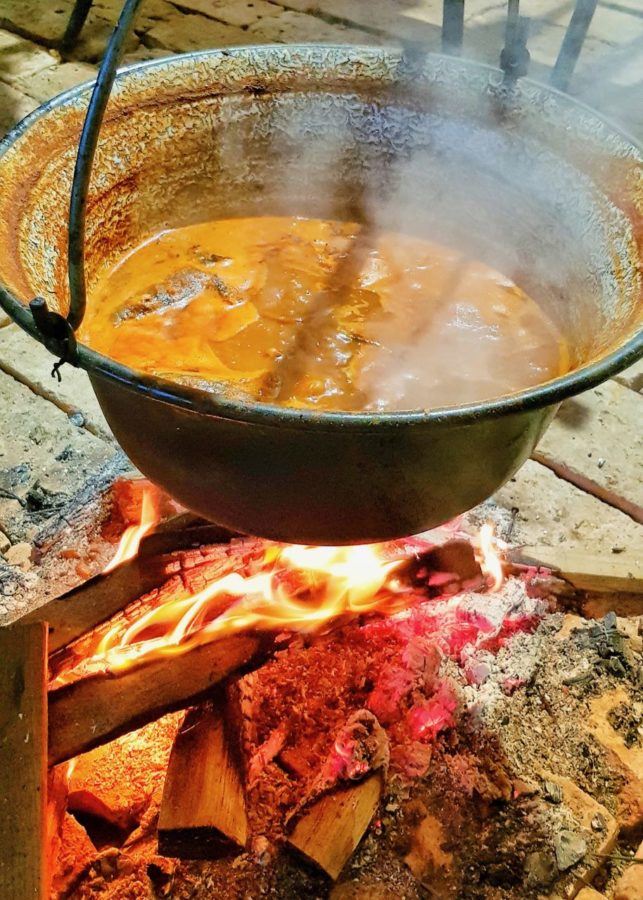
A spicy fish stew, paprikaš, is made with freshwater fish, which, like cobanac, is cooked in a fire.
Typically, a mix of freshwater fish is used, including carp, catfish, pike, and Slavonia’s staple, paprika. I love the look of the cauldron because it reminds me of how one may have cooked hundreds of years ago before kitchens.
28. Perkelt-od-soma
A typical dish from continental Croatia, particularly Baranja and Slavonia, perkelt od soma is a delicious stew originally from Hungaria. This is essentially Croatia’s version of Hungarian pörkölt. When visiting inland Croatia, you’ll often see perkelt-od-soma on local restaurants’ menus, besides other staples like fish paprikas and čobanac.
This hearty and spicy stew combines catfish, bacon, garlic, onions, and paprika. After sitting on the stovetop for a while, allowing the flavors to mix, it is usually served with cheese-and-bacon noodles.
29. Sarma
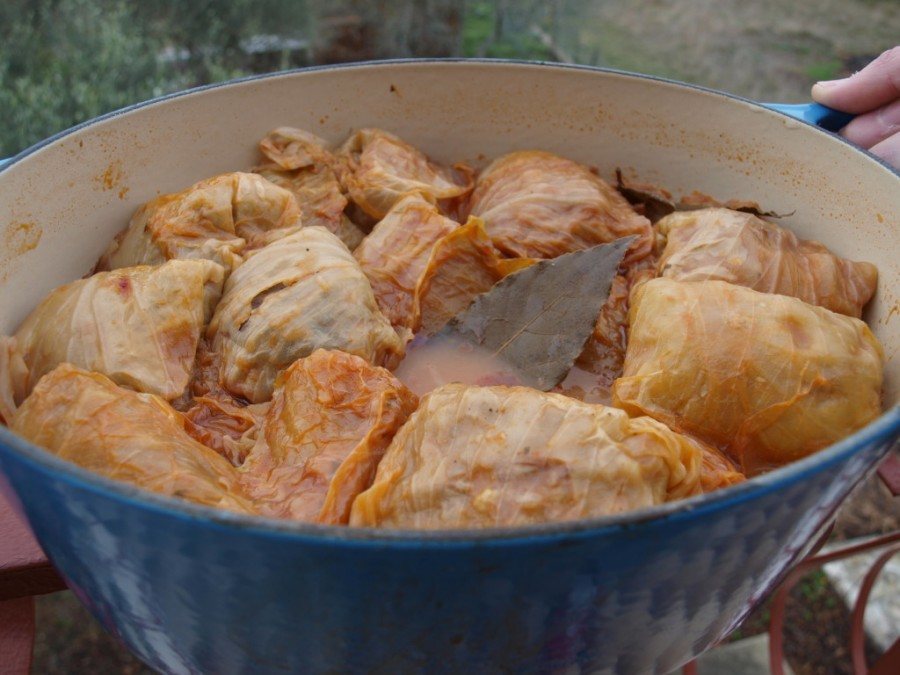
These little cabbage rolls are something you can find in many continental European countries, including Poland. All Croatians, however, will tell you that their sarma recipe is the best! That said, don’t be afraid to try these beautiful rolls throughout the Balkans.
Over the years, Mrs. Chasing the Donkey has honed her sarma-making skills and is good at preparing the smelly little rolls – for an Aussie, that is. Why are they smelly? I hear you ask. It’s because the cabbage leaves, in which you roll the meat, are pickled. If you have never tried these, give them a whirl. Don’t let the smell put you off.
30. Salami – Kulen

There is a long Croatian tradition of making salami and charcuterie. Slavonia’s finest salami is Kulen, which consists of various pork cuts, including the thigh, back, shoulder, and neck, and, of course, the most essential part, belly fat.
It’s then seasoned with spices, paprika, and garlic and packed into the pig’s caecum (a pouch that connects the small and large intestines). Once loaded, the salami is cold-smoked and air-dried for five to nine months, depending on its size.
Other noteworthy Croatian salami is a spicy pork salami from Turoplje, Svargl from Slavonia, and Samobor salami, which even holds an annual Salami Festival.
Kulen and kulenova Seka from Slavonia are sausage-type products and only a few indigenous Croatian products that enjoy EU protection. Only the best pork meat—there are age and weight guidelines for the pig—is used to make Kulen. All fat and connective tissues are removed, after which paprika, salt, and garlic are added. The Kulen-maker, a respected profession that even has grandmasters, then stuffs the mixture into a cleaned blind gut of a pig.
Kulenova Seka is a paprika-flavored and dried sausage very similar to Kulen. The only difference is that the Kulen mixture is stuffed into a smaller intestine, creating a slightly smaller sausage. If you’re not a vegan or vegetarian, you must try this most authentic of Slavonia foods. I swear I ate like 2 kg of it that week.
The best Kulen products are made using the black Slavonian pig. These pigs were raised by crossbreeding several pig breeds starting in the 1860s in the area around Osijek.
The breed is a meaty, high-fat pig with a solid structure, black in color, and exceptionally resilient. In the first decades of the 20th century, this breed rapidly expanded throughout eastern Slavonia until World War II. Now, these pigs are getting rarer, though. It is said that only a few hundred pigs remain due to introducing of new, more productive crossbreed pigs that are better adapted to industrial-style farming.
31. Deer Stew
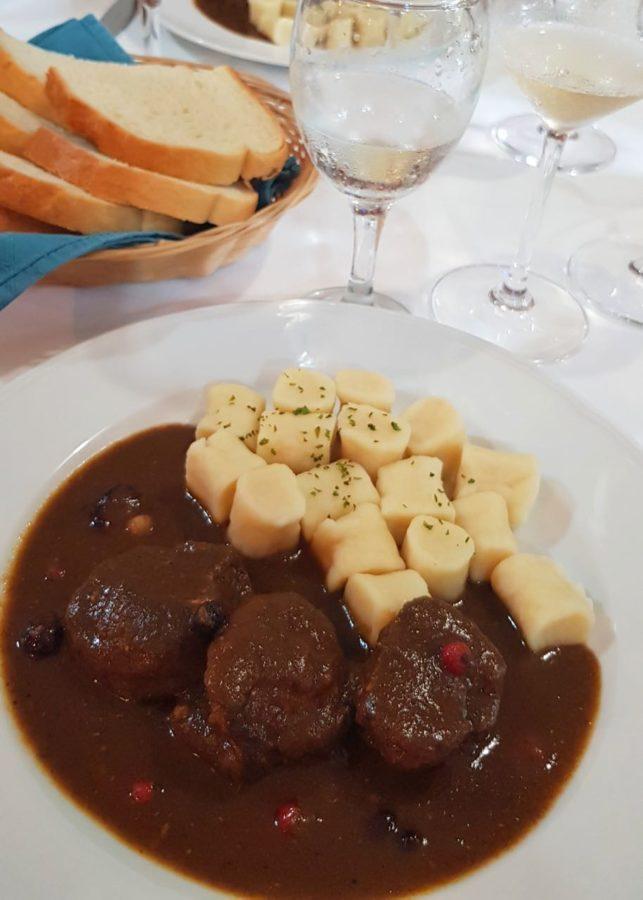
In Slavonia, you can enjoy deer stew. I first tried it in the Virovitca area, and I knew it had that ‘game’ flavor as soon as I tasted it. People at my table said it was a pig, but there was no way, not with such an intense flavor.
Of course, if you do not like that ‘gamy’ flavor, you should avoid it, but it is often served with gnocchi, which is perfect for soxaking up that brown sauce.
32. Čvarci
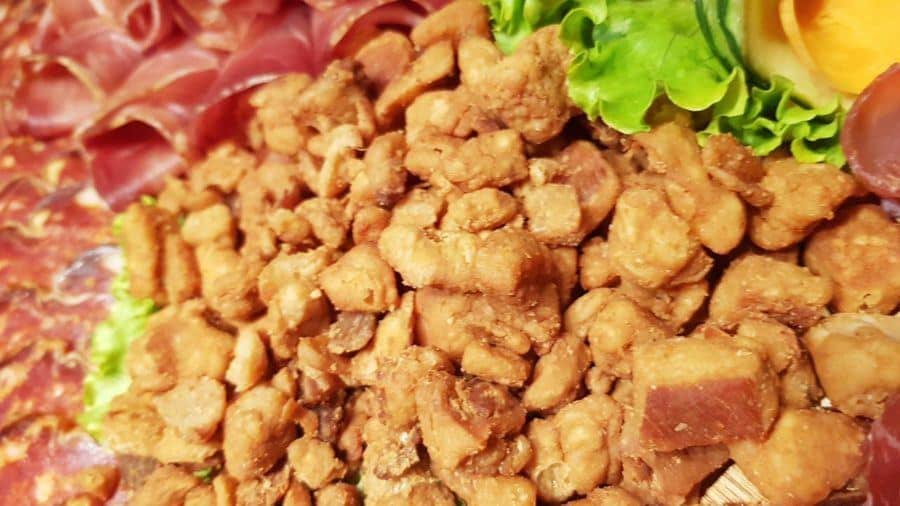
Čvarci (pork rinds) are served along with Kulen and various kinds of cheese on a platter. Yummy! It’s fried skin from a pig. It may not sound appealing, but these fried or roasted snacks are like crisps. And, just like crisps, I found them highly addictive!
33. Zagorska Juha – Zagorje Soup
Zagorje soup is a hearty soup with porcini mushrooms, carrots, potatoes, bacon, onions with spices, and sour cream. It is a specialty of the Zagorje region and is claimed to be an excellent hangover cure.
34. Klipići
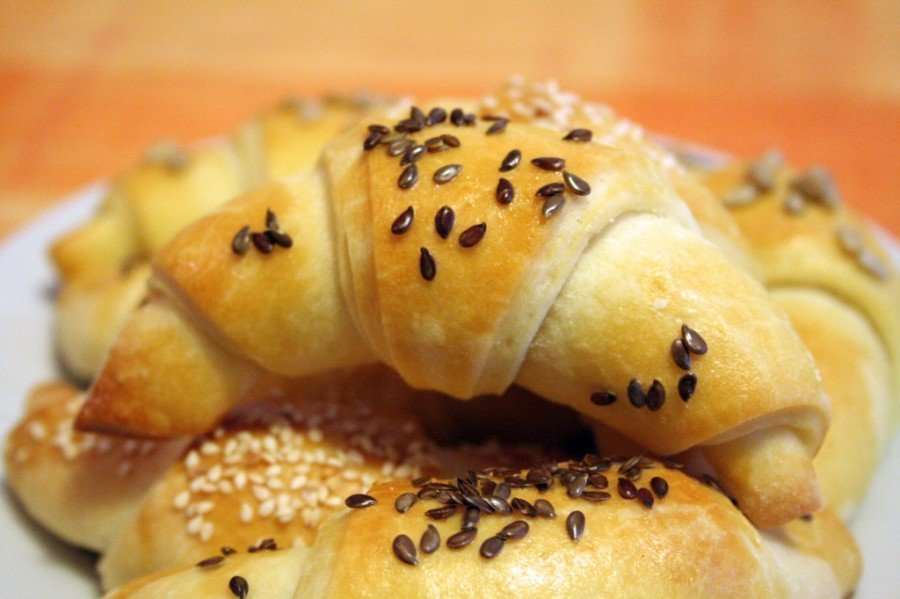
Klipići is a savory roll made in the continental part of Croatia, mainly in Zagorje, Podravina, Međimurje, and Slavonia.
These rolls can also be filled with various fillings and poppy seeds. They are little crescent-shaped pastries, and as with almost every food in Croatia, there are many different regional versions of this dish. As such, it is known by several other names.
35. Krvavice Aka Čurke
Look away now if you’re not a fan of food made with offal products!
Krvavice is basically a blood sausage. This means pork blood and a filler, usually barley, cornflour, or buckwheat, containing various pig parts. That’s not giving it the most positive write-up, but it is very popular and surprisingly delicious. I promise!
This sausage is usually eaten during the winter because it is hearty and warming and is often served with sauerkraut, potatoes, and onions.
36. Salenjaci
Also known as “Croatian croissants with character,” salenjaci are a sweet dessert from Slavonia. What distinguishes this one from other continental Croatian desserts is the use of pork leaf lard. The highest grade of lard, leaf lard, has a minimum pork flavor, making it perfect for baked goods. It produces impressive flaky, moist pie crusts.
Traditionally, salenjaci were made in wintertime in Slavonia, during the slaughter season, when an abundance of pork lard was available. Salenjaci are layered pastry wraps with a hearty filling of homemade jams and/or ground walnuts. They may also have a dusting of icing sugar on top. We will tell you exactly how to make salenjaci at home here.
37. Orahnjača
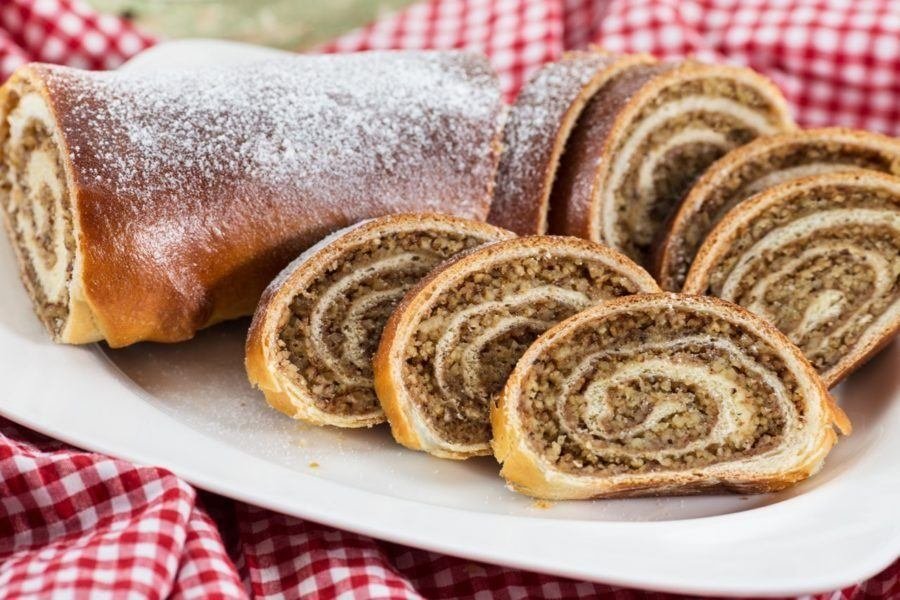
This is a yeast bread filled with walnuts. It is neatly rolled to form a delicate swirl inside the cake. It was often served at Christmas time and just great on a Sunday afternoon with a cup of tea. Definitely a delicious traditional Croatian food for any time of the day!
More Continental Croatian Food Options
38. Zagrebački Odrezak – Zagreb Schnitzel
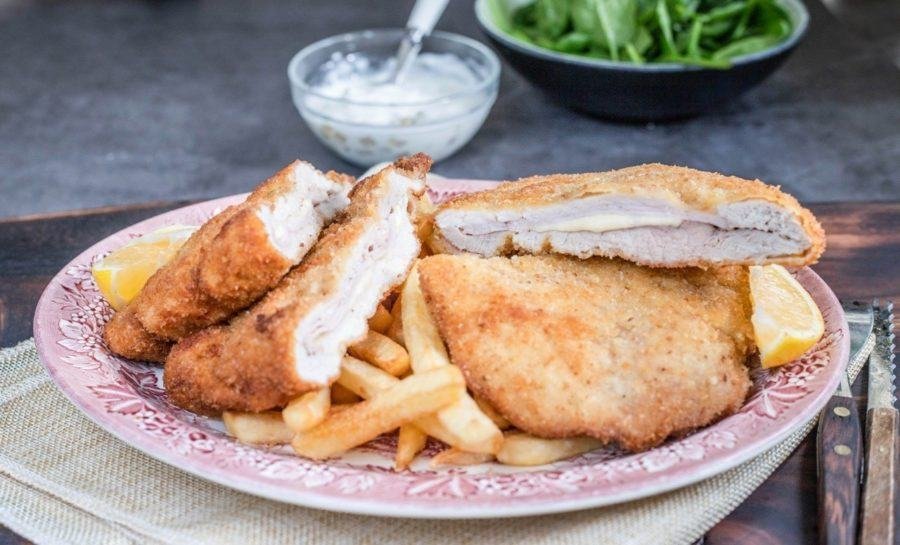
This is a tasty dish you’ll find everywhere in Croatia, but mainly in the Zagreb region, hence the name! A meaty dish that is very filling and great for the winter months is a veal schnitzel, rolled and filled with melted cheese and ham. The outside is crunchy, and it is most commonly served with potatoes in some guise, and a little salad, of course.
Move This Adventure To Your Inbox & Get An Instant Freebie

No spam. Unsubscribe at any time.
Super Popular Croatian Food
39. Roasted Whole Pig Or Lamb
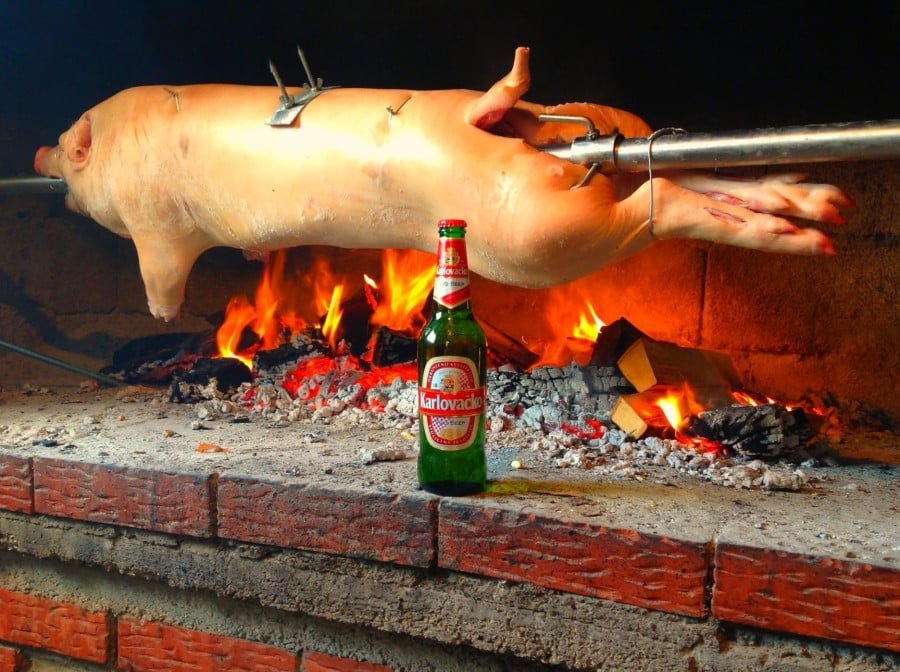
You might think this looks like something from medieval times. And, well, maybe it once was, but you will see a whole pig or lamb roasted on an open fire (known as a spit roast) quite a bit as you road trip across Croatia. This traditional Croatian food is so special in how tender the meat is once it lands on your plate. If you are on Pag Island, be sure to try the lamb. The island is famous for its lamb dishes.
40. Cevapcici
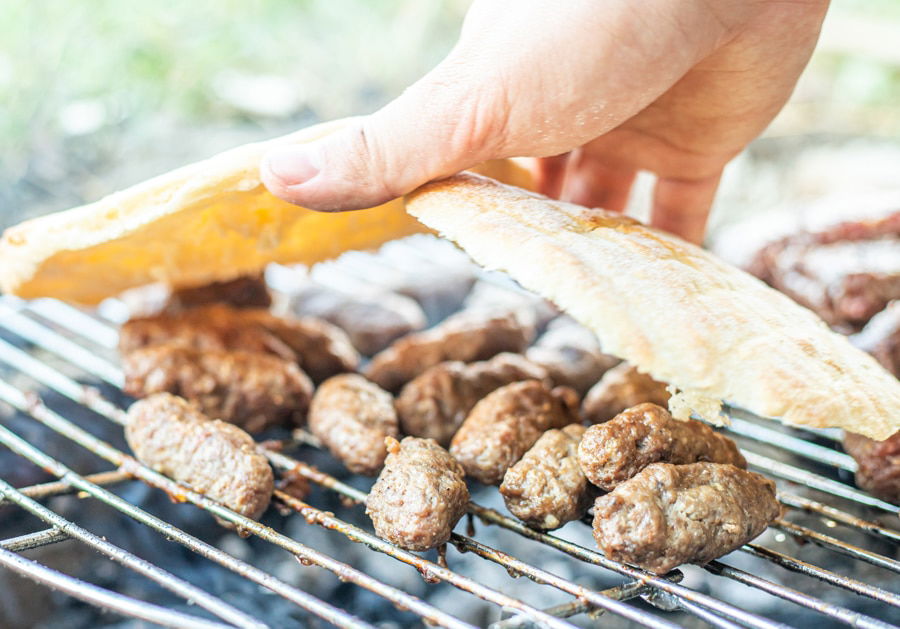
It doesn’t matter where you go in the Balkans; you will find cevapcici anywhere. These are tasty sausages, minus skins, and are usually made of both beef and pork combination, along with seasoning to make them super-delicious. You’ll find them served on a flatbread as a sandwich, usually with chopped onions and a pepper-containing relish with a bit of spicy kick known as ajvar.
41. Burek
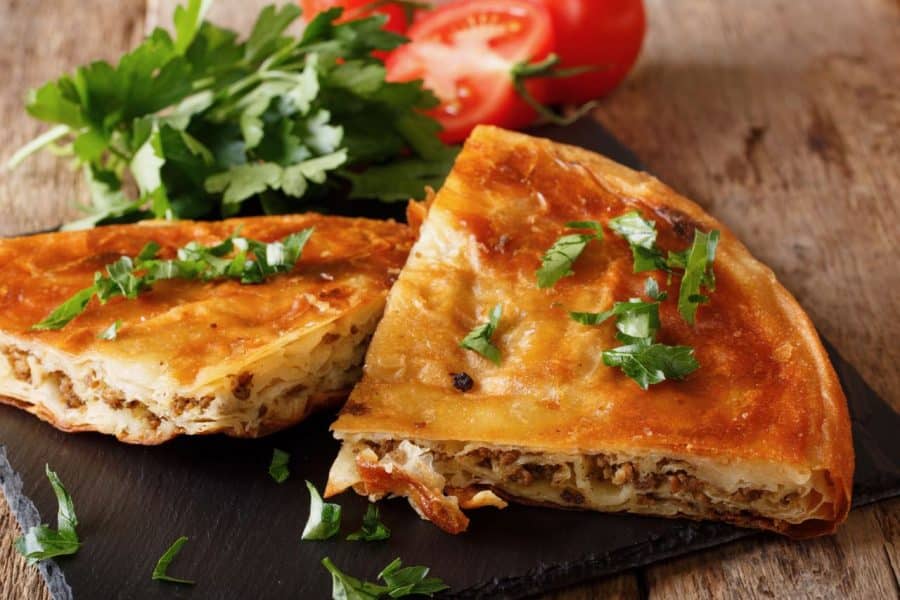
You’ll find this pastry dish in various countries around the region, with similar-sounding names, but it is called burek in Croatia. This flaky pastry is layered and filled with different fillings, such as meat (usually beef mince), cheese, spinach, and sometimes potato or apple.
This is a very popular on-the-go snack, so you’ll find it everywhere across the country in bakeries. For those with a sweet tooth, try the apple-filled version with a cup of coffee for breakfast. Are you hungry now? I hope this list piqued your interest in traditional Croatian food. If you are planning on heading to Croatia, try them all. Okay, try as many as you can. These are just the tip of the iceberg regarding Croatian food.
Depending on where you travel, there will be dozens more traditional Croatian foods to sink your teeth into.
New Foods I Just Discovered
42. Gregada (Hvarska Gregada)
Gregada, also known as Hvarska Gregada, is a traditional Croatian fish stew from the island of Hvar in Central Dalmatia. This dish, which dates back over 2000 years, is thought to have been introduced by Greek settlers. The main ingredients are white fish, potatoes, onions, garlic, and parsley, cooked together in olive oil, white wine, and water.
To prepare Gregada, onions and garlic are sautéed in olive oil, followed by the addition of sliced potatoes. The fish, such as sea bass, grouper, or monkfish, is then layered on top. The pot is filled with white wine and water just enough to cover the ingredients, seasoned with bay leaves, salt, and pepper, and simmered until everything is tender and the flavors meld together.
Traditionally, the fish is left whole with the head and bones intact to enhance the flavor. The dish is often served with homemade bread and a glass of local white wine, making it a humble yet delightful culinary experience.
So, now that you know what food to eat in Croatia, I bet your taste buds are tingling- right? So, what will be your first Croatian meal?


Nice to see the fresh version of the article :) Thanx for accepting sime of my advices :) Hope to be able to comment on fb again. Best regards
We’re always glad to learn new things, so thanks for sharing your advice Manuela. We welcome you to the FB page – just remember we are real people, with real feelings.
Good work variety of Croatian Food according to the different areas
Thanks!
Food looks so delicious and tempting too :) I think Croatia have many pages to revealed about the food and I wish if the list carries some vegetarian food also.
someone did homework very very good
bravo
Giggle, thanks !
I love mussels and clams,simply steamed,and octopus salad on the coast!
Palacinke, Knedle, Kiflice, Pecene Sardine, Grah, Sataras. <3
I have celiac disease which means that gluten (found in wheat, rye, barley, malt, most soy sauce, most oats) will make me very sick.
Will I have a hard time finding food that is safe for me or helping wait staff understand my restrictions?
So many of these foods look delicious, but even a small amount of flour to thicken a sauce will make me ill.
Ohhh it’s going to be tough, I won’t lie. Stick to fish, salads, fries and risotto (you can eat rice huh). All goulash and things are very likely to have flour to thicken sauce. Good luck and enjoy.
I feel for you Kristen, I’m gluten intolerant so can tolerate small amounts if I have too, I am told European wheat is different and easier to digest unlike Australia’s heavily processed wheat but unhelpful to you being Celiac. Although it doesn’t usually bother me, my mother in law being Croatian almost thought I was an alien! Good Luck!
You can try Krvavice aka Čurke…it contain buckwheat and some pigs blood..I know it sounds strange..but it’s realy tasty. We make them ourself on northern part of Croatia every winter and prepare with sour cabage aka sauerkraut and mashed potato.
You don’t want to miss eat anything from peka! Belive it
Amazing!!!
My mother in law is Croatian and yes her “cabbage rolls are the best” according to her haha
We are visiting Croatia in September, can’t wait to try them all :)
Thank you x
Ohhh let’s see what you like best. Let us know after you’ve been.
You’re the best “donkey” – Thanks for this share – superb! :)
YUM! We ate like total kings during our 2014 honeymoon in Croatia. They’re cuisine is wonderful!
Thanks for all the wonderful information…
Will be returning to Croatia for our 4th visit next month. Thanks for sharing the ‘food to eat’ I’m more adventurous than my husband at trying new dishes but now I know what’s in some of the dishes I will be trying some more.
You are so welcome…. did you see this one too?
So very glad I’ve learned to prepare different dishes from various countries with excellent Croatian ingredients. (Italian, French, Indonesian, yes, sometimes even Dutch).
Knedle!
Croatia does seem to be a lively place. Great! :-)
An excellent Croatia! Love it!
i was hoping to find a croatian rotisserie chicken recipe.
if you could help out it would be
greatly appreciated
Sorry, I have never heard of that before.
my great parents were from crotia3 and my grandmother use to fix us podarane (poohens is what we call them). Please me find the recipes. I want to be able to pass this recipes to my daughters and family. I have found the pictures of it but there is no recipe. My grandmother didnt write down the recipes. I would be so grateful. My dream is to come to Croatia and find my relatives. My relatives were Poja, Troha and Policks
Sorry, I have no idea what podarane are.
Hey Mary Ann, what you mean is most likely “poderane gaće” – translated it means “torn undies” ;-) ….due to the cut in the middle. Just type that into your search engine of choice and you’ll find the recipe. It basically contains of flour, yeast, a little sugar, salt, an egg and water. This is kneaded by hand into a firm dough- it shouldn’t stick to your hand any more…leave to rise….and after the dough has risen nicely it is rolled out and cut into rectangular/ diamond shaped pieces with a cut in the middle. The shapes are fried out in oil (sunflower or similar oil without a strog taste and suitable for hot frying). First, fry one side until light brown, then turned on the other side until finished. Then take them out onto kitchen paper to soak up some grease. You can eat it salty or sweet. I hope this is what you meant. If not, it’s still an excellent recipe to try. Enjoy :-)
So great to discover a post on our food that has more than burek and black rice – someone with some originality!
A lot of those are not Croatian at all. Some are genuine Croatian dishes a lot are actually regional in particular the Bosnian dishes burek, cevapi….
*Rolls eyes*, when it has been in Croatia for hundreds of years, it’s safe to say it can be on the list. Bosnians don’t own them either – the Ottomans do.
Croatian cuisine is a unique combination of many dishes found also, and maybe originating from, other national cuisines. However, those have been present in Croatia for centuries and by all means are part of Croatian culture. So, if someone wants to argue if some dish is originally from Croatia, Italy, Bosnia or Hungary, as a Croatian I would not participate in such discussion, but if someone claims dishes listed in this article are not part of Croatian shared taste in food, well, he is just ignorant.
And for the part if something is originally Bosnian or Ottoman… story is even more complicated. Many times Bosnian identity is suppressed and there are claims that whatever is Bosnian must be of Ottoman origin.. well.. if you travel to Anatolia you would be surprised how much Ottomans actually adopted from Bosnia, so what you think is Ottoman in origin, is just a wrapper around Bosnian tradition. Pick your fight wisely, otherwise you might turn out ignorant yourself.
I want to eat EVERY single dish…RIGHT NOW! MMMMMMMMMMMMMMM
I know, us too. Nom nom nom
F*ckin?amazing things here. I am very glad to look your article. Thank you a lot and i’m taking a look forward to contact you. Will you kindly drop me a mail?
I play internet games with a friend who is Croatian (I am USA) and he tells me to try some recipes (I am also cook). This website is most legit one he says, all recipes on point, and tasty! Thanks!
Wow, that’s a huge compliment. Thanks for the feedback. Let us know what you find that you like best. Dobar tek.
As a Croatian who lived for 20 years in continental and another 20 years in coastal Croatia, I confirm this is the best comprehensive guide on Croatian cuisine. This is what we eat at home, and this is what we crave to get in restaurant. I can’t think of anything omitted here and there is nothing to remove. Great work.
All of these Croatian food dishes look so tasty. I was intrigued by the seafood dishes.
Fabulous list, Im hungry now just looking at it! I didn’t see my favorite dessert though….Kremsnita (Krempita). The BEST I’ve ever tasted was in Samobor where it apparently originated.
Is it possible to find in restaurants specific fish — pike?
We are off to Croatia for an all-inclusive holiday and I am now very happy to at least try quite a few of the local dishes, this is a great article for people like me who may be a bit apprehensive about trying new food. Thank you.
Are the Croatian recipes available?
Thank you!
Many of these we have recipes for, just click the link where it shows you the option to do to the recipe. I add more as I can. Dobar tek.
I heard about some food that is cooked on a stick, what is that?
The food you’re referring to is likely “Ražnjići”. Ražnjići are skewered meat, commonly grilled and popular in Croatian cuisine.